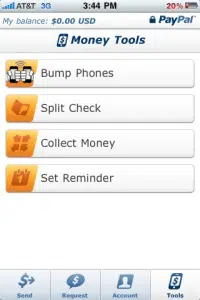A new technology from US start-up Bump, which lets consumers use phones equipped with accelerometers to make peer-to-peer payments and share images or contact details, has been adopted by PayPal for its new Send Money service.

PayPal has launched a new service that enables consumers to make payments by simply ‘bumping together’ two mobile phones.
Send Money can be used to make an instant peer-to-peer transfer of funds from one PayPal account to another, either between two consumers or between a consumer and a merchant or service provider such as a plumber or a market trader.
As well as a straight transfer of funds, Send Money also enables users to:
- Split a bill. This function makes it easy for users to divide up the cost of a meal for up to 20 people and quickly reimburse each other for their share of the cost.
- Collect money, by requesting funds from multiple people for a joint gift, team dues or concert tickets. “Users can send gifts of money on the spot for birthdays, anniversaries or any moment of impulsive generosity,” says PayPal.
- Set reminders for recurring payments from their PayPal account.
PayPal Send Money requires a PIN or password for every transaction to help prevent unauthorised use and includes a global currency calculator. It is available from launch in 15 languages.

While PayPal’s service currently works only with Apple’s iPhone and iPod Touch, Send Money is built on technology developed by US start-up Bump Technologies which has already introduced versions for Android devices and plans to introduce the service to other platforms in the near future.
And, while PayPal is using Bump for funds transfer only, the technology equally enables a range of other P2P transfers, such as sharing photos and contact information and interacting on Facebook.
To use the service, consumers simply download the Bump app to their mobile device and then, when they wish to make a transfer, they simply bring their phone into contact with another using a sideways ‘bump’ action.
“The app on your phone uses the phone’s sensors to literally ‘feel’ the bump, and it sends that info up to the cloud,” Bump explains. “The matching algorithm listens to the bumps from phones around the world and pairs up phones that felt the same bump. Then we just route information between the two phones in each pair.”
“We use various techniques to limit the pool of potential matches, including location information and characteristics of the bump event,” the company continues. “If you are bumping in a particularly dense area (for example, at a conference), and we cannot resolve a unique match after a single bump, we’ll just ask you to bump again… if you are in Chicago, we use that info so we don’t have to compare your bump with bumps coming in from Japan, Europe, New York, etc.”
“When you bump, if we find a match with a phone that felt the same bump, our servers ask each phone to send up the contact information each user chose to share, but nothing more,” Bump adds. “If and only if both users then confirm that the match is indeed correct will the contact information be sent down to the other person.”
“Today, there are several other phones that include the sensors that Bump needs to feel bumps, but in the next few years, the vast majority of new phones will have these sensors,” the company continues. “We plan to offer Bump on all of them, and Bump will work between any two of them.”
Next: Visit the NFCW Expo to find new suppliers and solutions